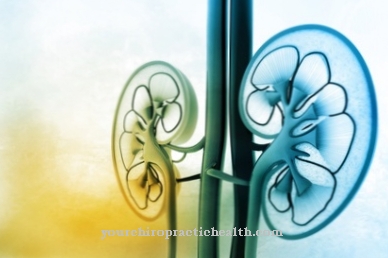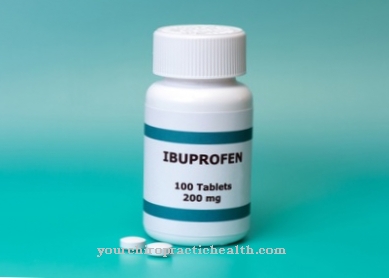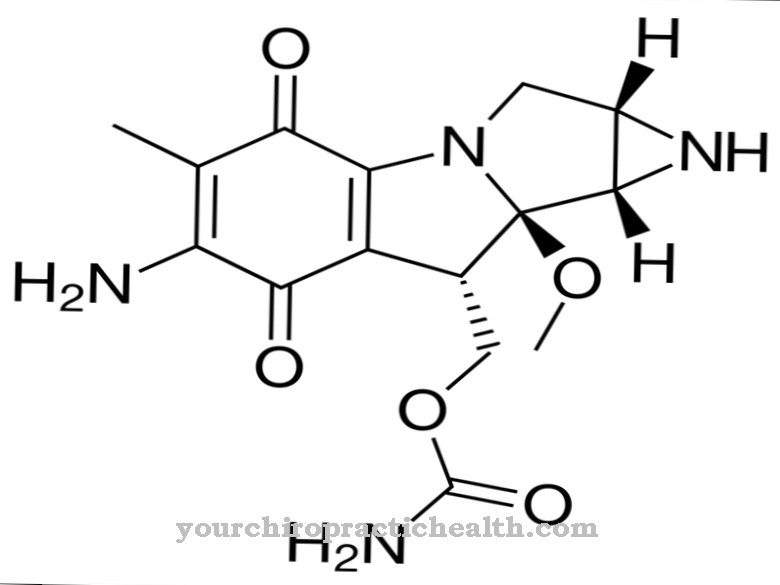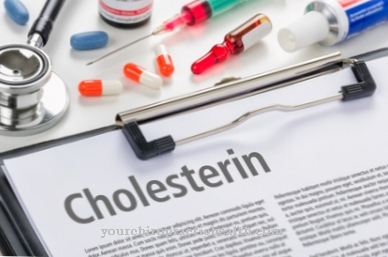Sodium chloride is also under the name Table salt known. This active ingredient is used as a sodium chloride solution (saline solution) or tablets to make up for a lack of chloride, fluid or sodium. Sodium chloride is used as a volume replacement for severe blood loss.
What is sodium chloride?

Sodium chloride (common salt or salt) is obtained as the sodium salt from hydrochloric acid. The chemical formula is NaCl. A saline solution is given in the event of excessive fluid loss associated with a lack of chloride or sodium. A sodium chloride solution can make up for high blood loss by giving it systemically to the patient via a drip. Sodium chloride solutions are also used topically for so-called dry eyes or to reduce swelling of the cornea after an eye examination.
Sodium chloride is also used to moisten bandages and cloths and to treat wounds. A nasal rinse as an accompanying therapy for a sinus infection and runny nose has a soothing effect on the mucous membranes. The active ingredient is also used as a carrier solution for other drugs.
Pharmacological effect
The fluid balance and the sodium content of the human organism are closely related. If the sodium concentration deviates from the norm, this negative value also influences the fluid content. An increased sodium level means an increase in the fluid content, a decreased sodium content leads to a decrease in the amount of fluid in the body.
By supplying a sodium chloride solution, a lack of sodium is compensated and the body is supplied with fluids at the same time. At the same time, an existing chloride deficiency is compensated. Chloride plays an important role in the acid-base balance and protects the organism from over-acidification.
Sodium chloride has a slightly disinfecting effect and is suitable as a wound pad. In the case of diseases of the kidneys or the digestive tract, a sodium chloride solution balances the fluid and electrolyte balance, since diarrhea, vomiting and reduced food and fluid intake can cause a mineral deficiency and dehydration (dehydration).
Another area of application is the cleansing (enema) of the rectum in order to clean individual intestinal sections before a colonoscopy or surgical removal. Enemas are used to make bowel movements easier for those with indigestion as they thin stool and stimulate bowel movement.
The saline solution must be isotonic, since the enema otherwise unintentionally withdraws or adds fluid to the circulation via the intestines. Saline solutions are matched to the saline content of the blood plasma, the plasma osmolality. It is an osmotic concentration. The osmotic components of a saline solution relate to the dehydrating effect. In medicine, 0.9 percent isotonic saline solutions are predominantly used. For these sodium chloride solutions, nine grams of table salt are dissolved in one liter of water. A preferred solution is Ringer's solution, which contains sodium chloride, sodium hydrogen carbonate, potassium chloride and calcium chloride. There are also 10 and 45 percent hypertonic saline solutions.
Medical application & use
Patients who have suffered a high level of blood loss, for example during an operation or after an accident, are given a 0.9 percent sodium chloride solution to replenish the blood volume. Sodium chloride is dissolved in water and given intravenously to the patient. This solution is also called isotonic or physiological saline solution if its components have the same composition as the blood. This isotonic property is important when giving an infusion to replenish body fluid and blood without affecting the blood volume with regard to its composition with sodium, chloride and water.
The ancients treated infected wounds by sprinkling table salt directly into the wound site, which was accompanied by severe pain due to the burning sensation. The saying “sprinkle salt on the open wound” also goes back to this ancient practice. Salt has a strong osmotic (dehydrating) effect on the cells and destroys pathogens such as bacteria and microorganisms that accumulate around and in the wound. The disadvantage is that not only the pathogen, but also the affected cells are destroyed.
Modern medicine uses sodium chloride to moisten wound dressings that are placed on the sore spots and thus promote wound healing by preventing the penetration and / or spread of germs.
Sodium chloride is also used in the spa area for brine baths or bath additives. Staying at the sea is healthy for all people who suffer from ailments of the respiratory organs such as bronchitis, pneumonia, chronic coughs or sinus infections. Inhalers with salt aerosol provide relief. The inhaled active ingredient moisturizes the mucous membranes of the airways and reduces irritation caused by flu-like infections, dry coughs, hoarseness and asthma. Mucus is released and the patient is able to cough up.
Nasal sprays with sodium chloride are also a useful treatment method. Sodium chloride can also be given to the body as tablets in the form of dietary supplements. These are sold, for example, under the brand names “astorin®cardio Tabs K”, “Sweden tablets” or as “DHU-Schüssler salts No. 8 sodium chloratum”. Table salt tablets can be a useful food supplement for regular physical exertion with heavy sweat loss. Even during a stay in tropical regions, table salt tablets can be a useful food supplement due to their fluid-regulating and slightly disinfecting properties. One tablet contains 225 mg sodium chloride. Adults take four tablets a day, which cover 69.34 percent of the daily requirement. The maximum dose must not be exceeded. Since improper use can upset the sodium and fluid balance, users should ask a doctor or pharmacist for advice before taking.
Risks & side effects
There are no restrictions when it comes to external use for rinsing wounds and nose. Contraindications are increased sodium levels in the blood, excess blood chloride and overhydration in the case of reduced or reduced urine excretion. A careful risk-benefit analysis is carried out in patients with a reduced blood potassium concentration, severe sodium deficiency, cardiac insufficiency, water retention in the tissue, pulmonary edema (water lung), severe kidney dysfunction, excess acidity of the body, as well as seizures in pregnancy complications.
If the patient is already being treated with cortisone (glucocorticoids) or the brain hormone ATCH, the administration of a sodium chloride solution should be avoided. There are no concerns during pregnancy or breastfeeding. In children, the doctor will decide on the dose of sodium chloride solution. It is based on the child's need for electrolytes and fluids.
Possible side effects are excess blood chloride, excess sodium, volume strain, venous irritation, venous wall inflammation, increased urination and diarrhea.



























